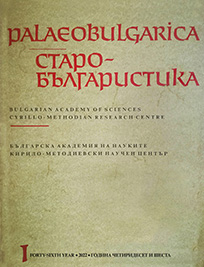За иконата на св. Георги Диасорит с позлатен обков от Музея за християнско изкуство в София (Предварителни наблюдения)
About the Icon of St George Diasorites with Gilded Revetment from the Museum of Christian Art in Sofia (Preliminary Observations)
Author(s): Ralitsa RoussevaSubject(s): Language studies, Language and Literature Studies
Published by: Кирило-Методиевски научен център при Българска академия на науките
Keywords: St George Diasoritеs; Byzantine and Postbyzantine art; Byzantine icons; Byzantine precious metal icon revetments; Byzantine metalwork; Nessebar.
Summary/Abstract: St George Diasoritеs, (14th–15th c., 16th c., 19th c.; wood, tempera; wax, silver, gilding, enamel, pearls, semi-precious stones; 78 x 49 cm; NG Inv. No. 601; AIM, Inv. No. KC–233). The original painting was almost completely destroyed, only fragments of the figure and the vestments, with golden lilly ornamentation have been preserved. The saint’s image was overpainted in the late 19th or even the early 20th century. The icon probably dates from the end of 14th to the beginning of the 16th century. The silver metalwork cover with gilding consists of many lamellae created in different epochs. Several of these background layers, which can be dated to the 14th–15th centuries, are the earliest. The major part of the metalwork covers, the nimbus and the body, can be dated to the 16th century. A highly unconventional decision was the insertion of a layer of wax between the icon and the metal ornaments of the armour plate, to create a sculptural effect. The embellishment is extremely rich, consisting of finely modelled plant and geometric motifs. One can find parallels of the ornamentation with some revetments from Palaeologian period from Ohrid and with the revetment of the Virgin Portaitissa (15th–16th c.) from Iviron Monastery. In the 19th century, lamellae were affixed to the lower section of the background and votive offerings were attached. The name and epithet of the saint are inscribed in two medallions of green enamel: Ο ΑΓΙΟΣ / ΓΕΩΡΓΙΟΣ – Ω ΔΙΑΣΟ / ΟΡΙΤΗΣ (‘St George Diasoritеs’). The metalwork cover is an exceptional achievement of the art of goldsmithery, executed with great mastery. The wealth of donations to the icon of St George over the centuries suggests that it was highly revered, probably as a miraculous icon. Nesebar can be cited as a possible place of origin.
Journal: PALAEOBULGARICA / СТАРОБЪЛГАРИСТИКА
- Issue Year: 2022
- Issue No: 1
- Page Range: 163-180
- Page Count: 18
- Language: Bulgarian
- Content File-PDF

